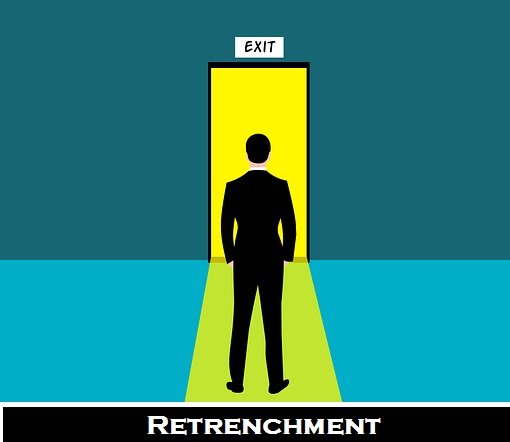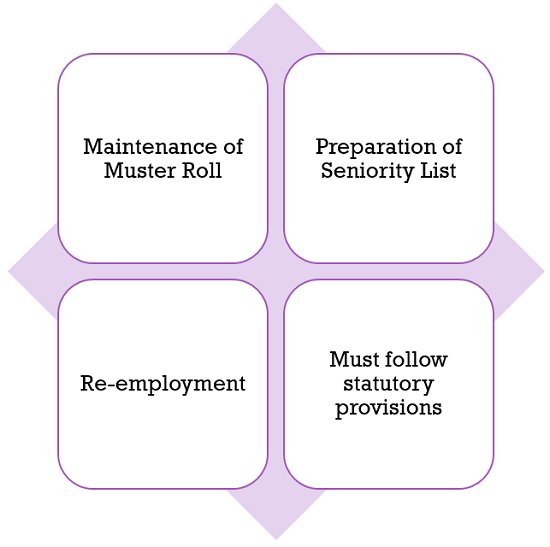Definition: Retrenchment is a situation involving permanent termination or discharge of an employee’s services by an employer for any reason whatsoever. It is forced on both parties, i.e. employer and employee. One can commonly see it in areas like plantations, agricultural services, food industry, machinery manufacturing and textile industry.
This takes place due to economic reasons, which can be:
- Rationalization of organization
- Closure of department due to constant lack of demand for products manufactured by that department.
- Installation of new machines that can possibly replace the existing workforce.
- Surplus staff in a continuing industry
- General economic slowdown
The legislature in this regard, ‘for any reason whatsoever’ states that it does not matter why the company is removing surplus workforce, if other conditions given in the definition as per statute are fulfilled, it constitutes retrenchment.
It involves the elimination of the dead weight of non-economic surplus, i.e. workforce. Besides, it is not necessary that the elimination of surplus occurs only when the company is facing losses. That is to say, retrenchment can occur at any level of profit.
What is not covered under Retrenchment?
Termination as a result of the given reasons does not amount to retrenchment:
- Disciplinary action
- Voluntary retirement of a worker
- Retirement on attaining the superannuation age
- Termination due to non-renewal of employment contract, on its expiry
- Termination of service due to completion of a definite term
- Employment termination due to health reasons
- Termination due to winding up of business
Conditions Relating to Retrenchment
- Retrenchment has to be by the termination of employment.
- The employer must issue one month prior notice in writing. Industrial Dispute Act, says that the company cannot retrench any employee without giving advance notice if he/she has worked for more than a year.Further, it must state the reasons for retrenchment. Also, it should indicate, that the retrenchment would be effective when the notice period is over. Or the company should provide wages for the notice period, in place of that notice.In addition, the notice must state the date of retrenchment or else mere writing would not be deemed as a notice. If the employer gives notice pay, issuance of notice is optional.
Note: It is compulsory for firms with over 100 employees to issue three months notice to the employees whose name appears in the retrenchment list. Also, they have to take prior approval of the Appropriate Government for retrenchment. But other organizations must serve one month notice in writing. - At the time of retrenchment, the employer must pay compensation to the employee. This compensation will be equal to the average pay of 15 days, for every completed year of continued service, with a maximum of 45 days’ wage per year. Workmen are eligible for compensation, even when there is the closure of the establishment.
Obligations and Duties of Employer in Retrenching Employees
Maintenance of Muster Roll:
The employer must keep and maintain a muster roll.
Preparation of Seniority List:
The employer should create a list of all workers in a specific category from which employees undergo retrenchment. The arrangement of this list is as per the seniority of service in that category.
Further, it must affix this list on the notice board at a conspicuous place in the factory premises. Affixing of the notice should take place seven days before the retrenchment date. This rule is mandatory and violation of this rule may make the retrenchment illegal.
Retrenchment should be according to the statutory provisions:
The basic rule of retrenchment is that –
First of all the firm should retrench junior most employees of a particular category.
Industrial Dispute Act states a proper procedure that the employer must follow, for taking a retrenchment decision. As per this Act, the retrenchment principle is, ‘first come, last go’ or ‘last come, first go’.
If the employer has valid reasons for not following this rule, only then departure is allowed. Besides, it must record the reasons for not following the rule.
Re-employment:
The retrenched employees have the right to get re-employment. If the employer proposes recruitment in the coming time. That means if there is any future vacancy, the employer must give preference to the retrenched staff over other employees.
A word from Business Jargons
Above all, Industrial Disputes Act has laid down strict rules in this regard. It occurs when the company discharges the excess workforce, from the undertaking.



Leave a Reply